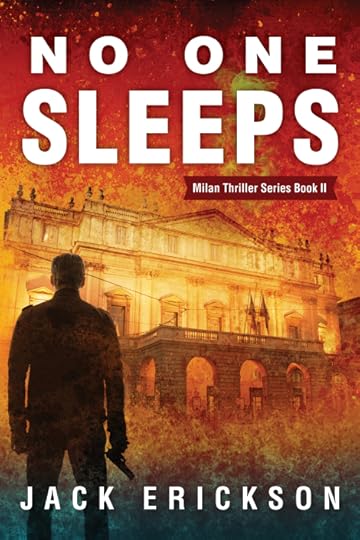Jack Erickson's Blog
August 26, 2023
Summer in Europe 2023
Denmark – Norway – Germany – Switzerland

The Little Mermaid
We recently returned from spending seven weeks in Europe — Denmark, Norway, Germany, Switzerland, and Italia. I’d like to share a few highlights of our summer travel advenure. This post will be about our time in Denmark, Norway, Germany and Switzerland.
In a later post, I’ll take you on a tour of our month in Italia, visiting Stresa on Lago Maggiore, Milano, Lucca, Volterra, and a couple agriturismos along the way.
Stay turned for that post later this month!
Copenhagen
We left San Francisco on May 31, flew to New York, then to Rekyavik, and arrived in Copenhagen June 1. We stayed with a Danish friend I had met at an Italian agriturismo, Torrazzetta, in 2016. Since then, we’ve met the family several times, once in Copenhagen on a layover, and they visited us in Monterey three times. Our time in Copenhagen was busy, touring that incredible city, taken a boat ride on the many, canals, passing by the Opera House and the popular The Little Mermaid sculpture from the story written by Hans Christian Andersen.
Anderson wrote many well-known stories including “The Ugly Duckling,” “The Snow Queen,” and “The Emporer’s New Clothes.”
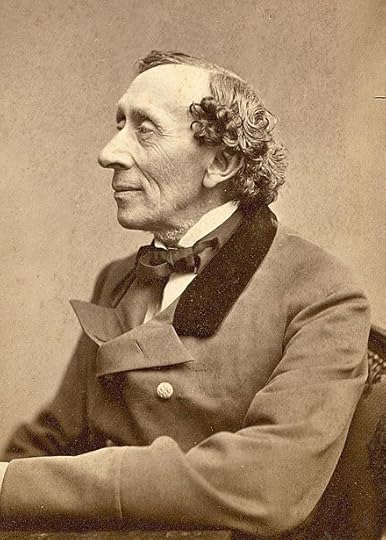
Hans Christian Andersen

The Little Mermaid
One afternoon, we took a canal ride through the scenic areas of Copenhagen, past the Opera House, the Royal Palace, the Parliament building, parks, and passing under many bridges crossing over the canals.
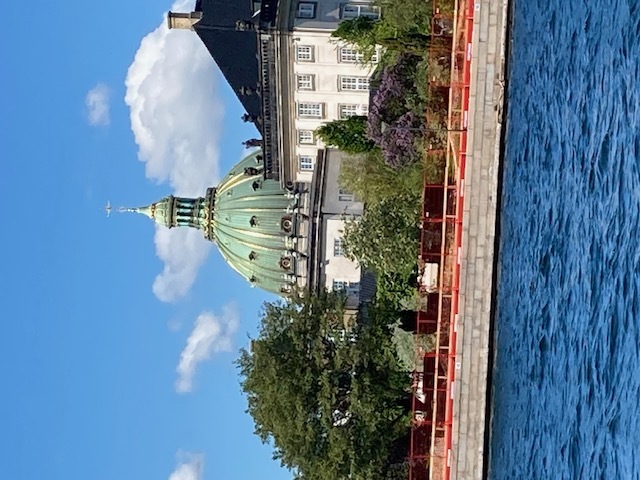
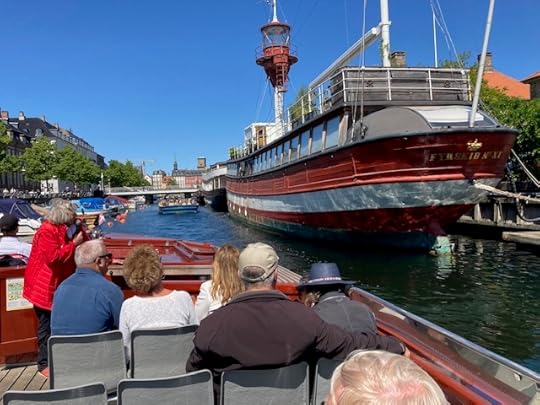
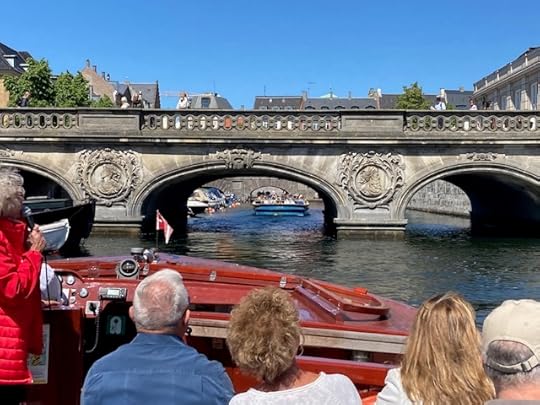
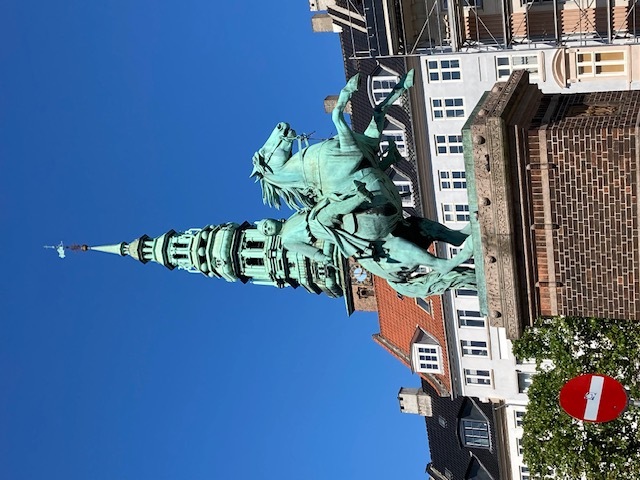
We were encouraged by our Danish friend to have a popular Danish food treat, smørrebrød, a sandwich with sourdough rye bread base, and layers of fish fillet, boiled cod, caviar, and shrimp. Between the layers were slices of tomato, lettuce, cucumber, and a tangy white sauce.
Delicious!

We visited the Danish national art gallery, the national museum, and the Danish Parliament where we had lunch. After lunch, we climbed steps to an observation tower near the top of the Parliament.
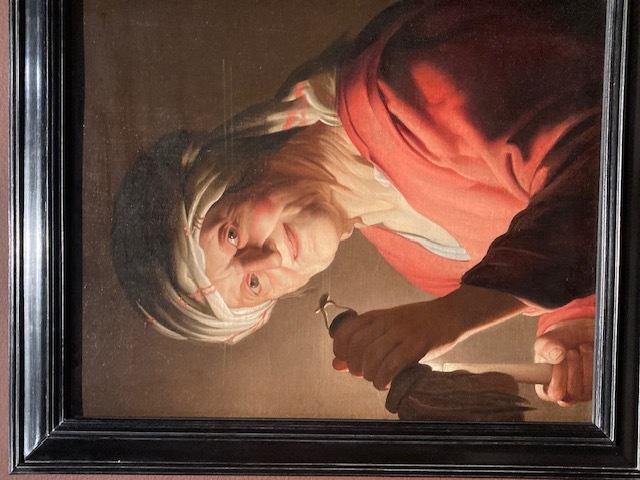
From an observation deck, we could see over Copenhagen’s panoramic setting, its canals, and many towers.
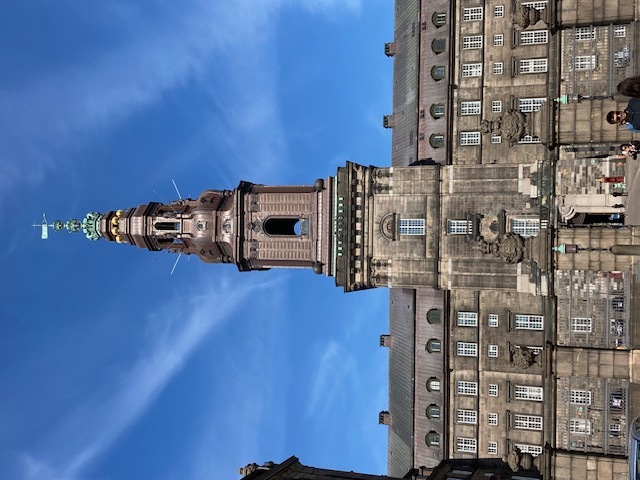

Oslo
After six days in Copenhagen, we boarded a ferry boat for an overnight, 19 hour journey to Oslo, Norway.
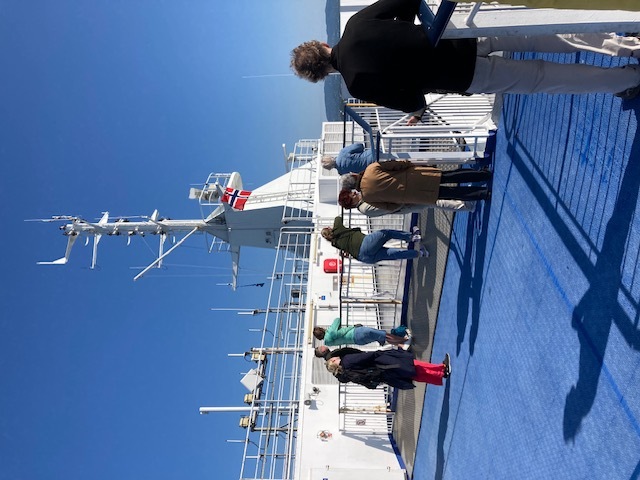
We sailed from Copenhagen into the North Sea and up fjords along Norway’s coastline, passing small islands, some inhabited, and seeing cruise ships, sail boats, yachts, and smaller ferries.
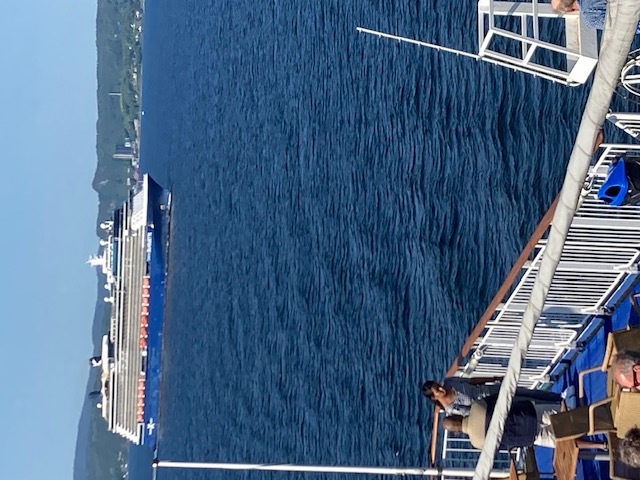
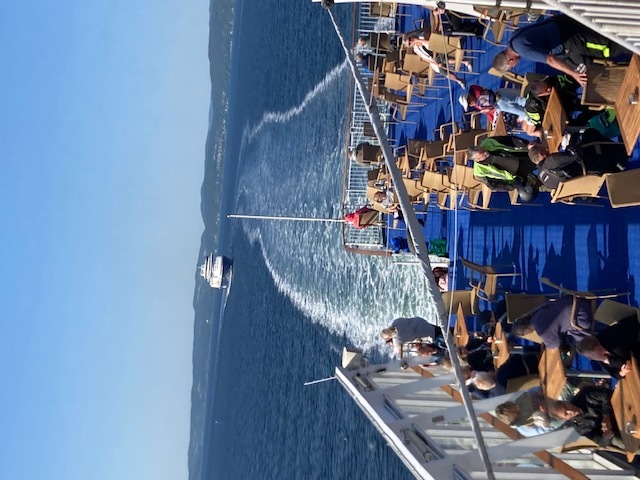
The weather was glorious, sunny, warm, blue skies and cool breezes, much better than the weather we had endured in Central California the last couple months.
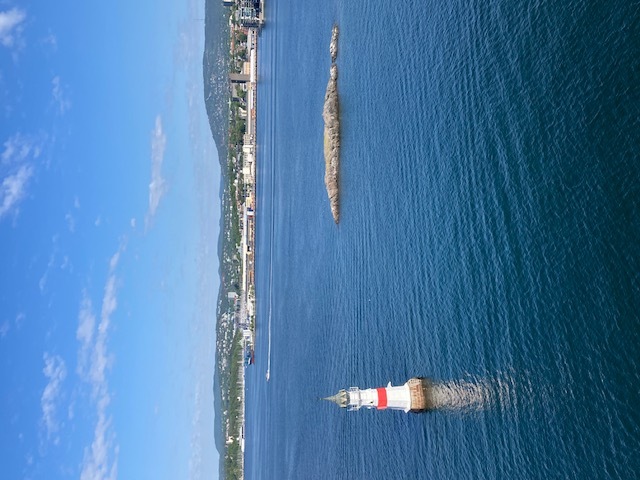
While in Oslo, we visited the impressive Opera House on the harbor. The Opera House was built in 2004 constructed with Italian White Carrara Marble.An amazing feature is that there are no square corners, but smooth slices of white marble around the Opera House and walkways that circle the structure. From the top, you can view boats and ships in Oslo’s harbor.

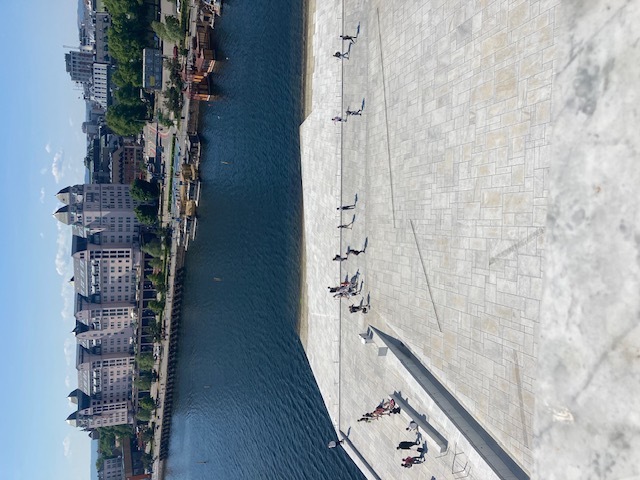
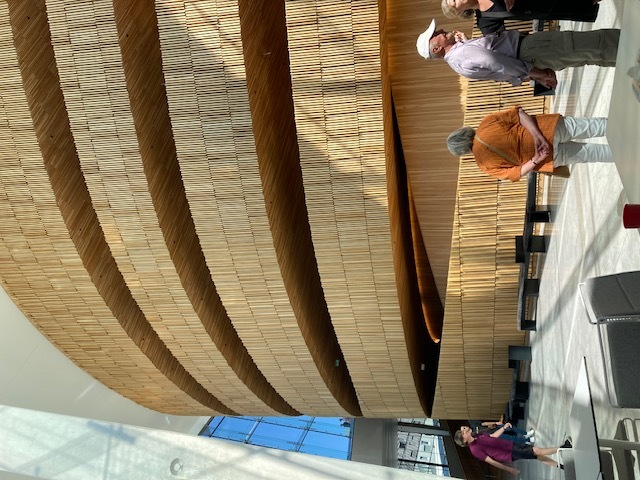
Inside the Oslo Opera House
Bergen
After two nights in Oslo, we boarded the Bergensbanen train for a journey to Bergen on the west coast of Norway. The train is the highest railway in Northern Europe. We passed through farms, villages, then up a mountain where we could see ice, snow, and frozen lakes. It was early June, but this part of Norway was still experiencing winter.

The journey started at 7 AM in the morning and lasted seven hours. We traveled through 180 tunnels along the way and made 22 stops, some in what was almost like wilderness.
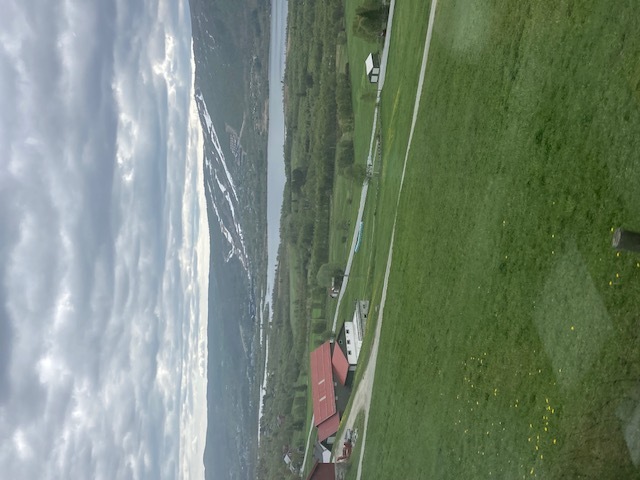

Bergen is smaller than Oslo and a UNESCO World Heritage site. Getting around the town was easy on buses or just walking along scenic streets with interesting architecture.
The main attraction for us was the Fish Market on a harbor where we could see cruise ships, yachts, fishing and sailboats. One afternoon, we took boat ride up a fjord, passing islands and homes along forested hillsides. We passed under a long bridge connecting two peninsulas, an impressive structure.
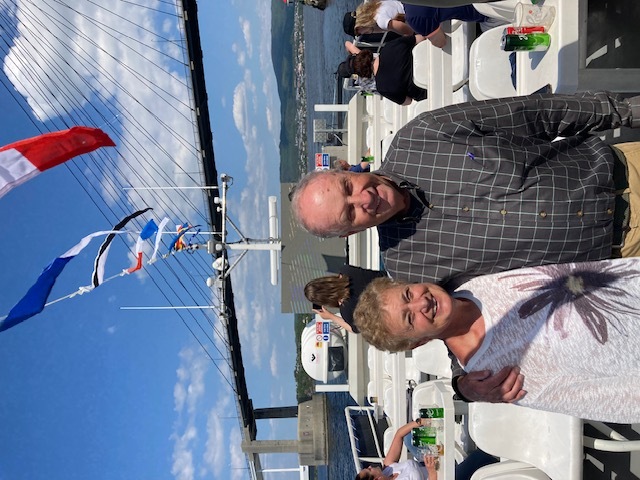
Friedrichshafen
We flew from Bergen to Friedricheshafen to spend a few days with the family of our daughter-in-law. We enjoyed casual breakfasts at their comfortable home in Obereisenbach, a rural setting with forests, hiking trails, and farms with corn fields, apple and pear orchards, and dairy cattle.
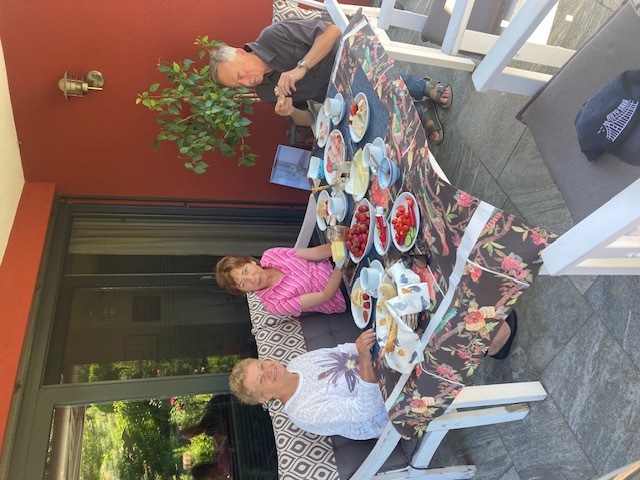
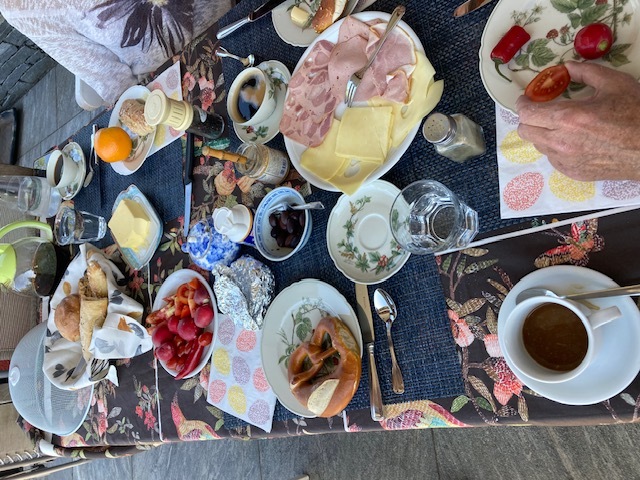
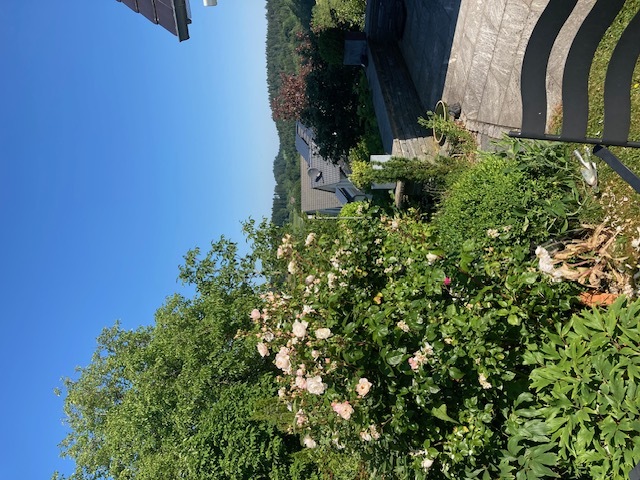
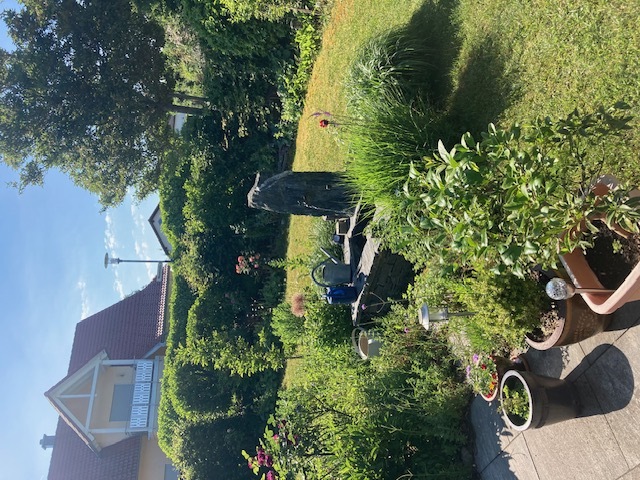
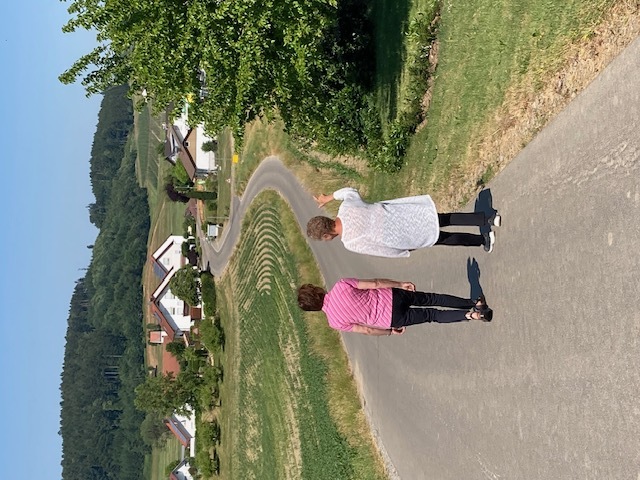
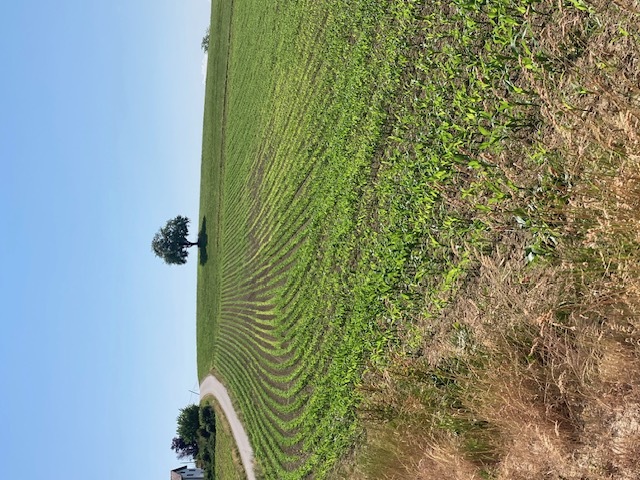
And of course, we had to have one of my favorite beers, a German wheat beer or Hefeweizen. We had an early dinner one evening, sipped the tasty, cloudy beer and watched sailboats out in Lake Constance (Der Bodensee).


Romanshorn
We sailed on a ferry boat from Friedrichshafen to Romanshorn, Switzerland, a journey we have made many times in the years that we have visited our daughter-in-law’s family.
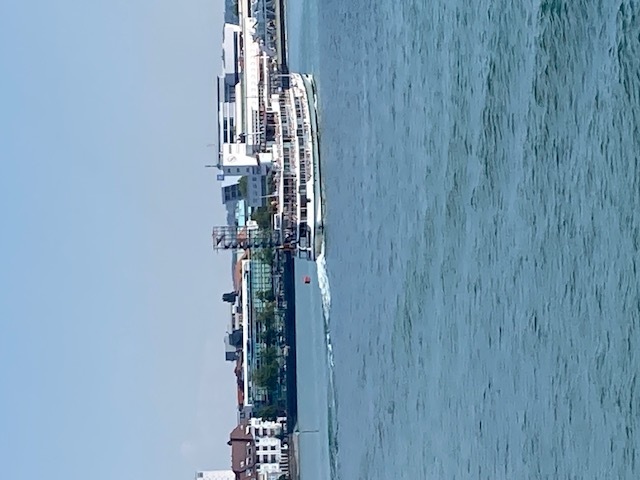
Depart Friedrichshafen, Germany
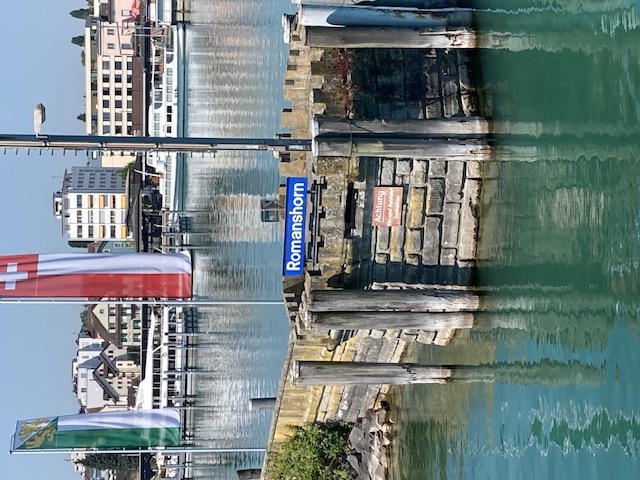
Arrive Romanshorn, Switzerland
We left the ferry boat, walked a short distance to the Swiss train station where we picked up a morning train to Zurich. When we arrived in Zurich, we transferred to a train departing for Bern, the Swiss capital. In Bern, we changed train for Murten an hour to the east.
Murten
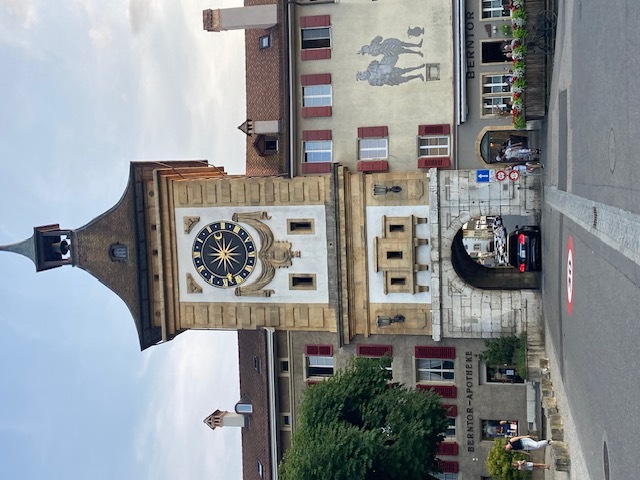
On a visit to Bern several years ago, I had taken a train to Murten for a day trip. But this year, we were going to spend a few nights in Murten, Murten is a historic setting near the French border, a former medieval village enclosed by brick walled fortress and towers. A famous battle took place in Murten in 1476 between the Swiss and French Army.Visitors can climb narrow wooden stairs to reach a level floor and walk along the fortress walls, stopping to look out on the city below, churches, gardens, and parks.
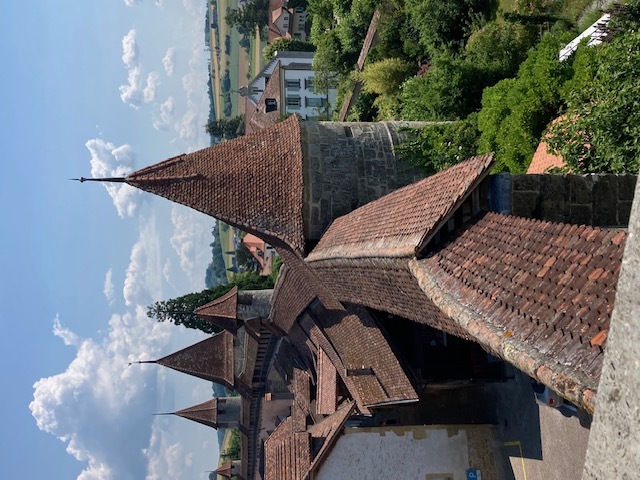

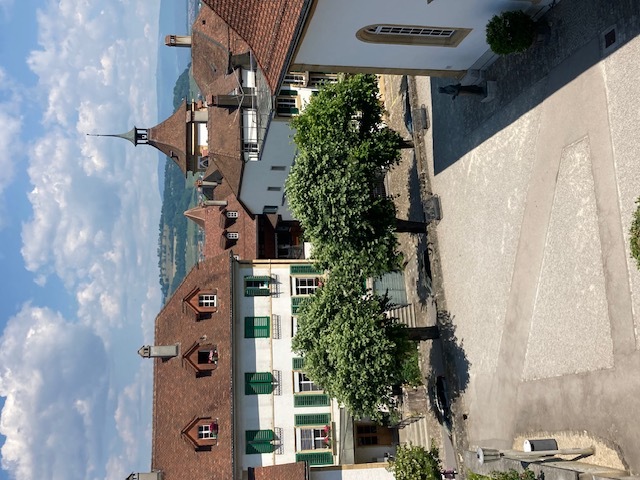
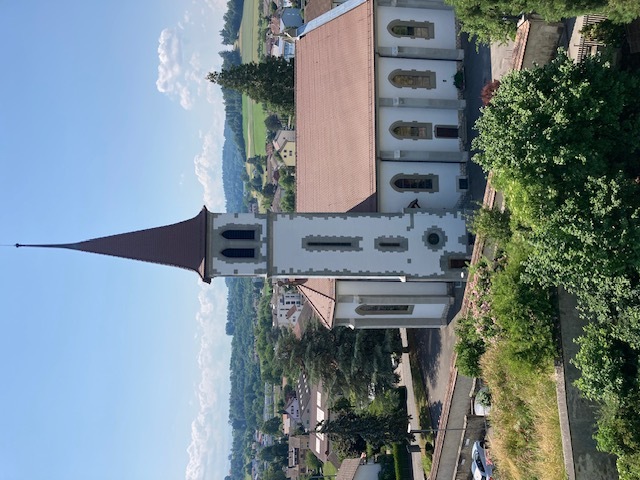
The weather was delightful! We walked through Murten’s narrow streets, passing interesting shops, restaurants, and a couple parks. One afternoon, we swam in MurtenSee, a lake just ten minutes from our hotel. We were so enchanted by the lake, we took a boat cruise around MurtenSee, stopping at hillside villages across the lake and viewing acres of vineyards.
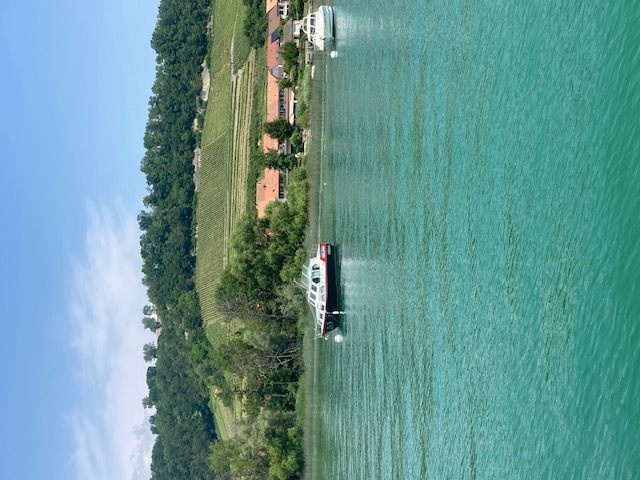
Cruising along MurtenSee
After four days in Murten we took a train back to Bern, transferred to another train bound for Italia. Our destination was Stresa on Lago Maggiore, one of my favorite places in Europe where I have visited many times.
I’ll post about our month in Italia soon – Stay tuned!
A presto —
Jack
* * * * * *
In addition to this travel blog, I write international thrillers, mysteries, short mysteries, true crime, and romantic suspense novels.
I’m currently writing the Milan Thriller Series featuring Italy’s anti-terrorism police, DIGOS (Divisione Investigazioni Generali e Operazioni), as they pursue domestic and international terrorists.
I travel to Italy every summer for research, to see Italian and American friends, to work with my researchers, and to meet DIGOS agents at Milan’s Questura (police headquarters) who advise me with their investigative procedures.
If you’d like to receive a free ebook of the first book in the series, Thirteen Days in Milan, please sign up on the left side bar. I just need your name and email address.
You can find the Milan Thriller Series and all my ebooks at digital book sites and on my publisher’s website, RedBrickPress.net. Book 4 in the Series, The Lonely Assassin, was published as a paperback in 2022.
Paperbacks of Thirteen Days in Milan, No One Sleeps, Vesuvius Nights and The Lonely Assassin are available at RedBrickPress.net, Amazon, and independent bookstores. If they’re not in stock, stores can order from the Ingram distributor. You should have your book in 3 or 4 days.
If you’d like to learn more about Italy, travel, and writing, sign up for my email newsletter at my publisher’s website or my personal web site jackerickson.com.
I like hearing from readers! Please email me and tell me what you like to read. And please share this site with friends who like to read about travel.
Find my books in Apple’s iBookstore At Barnes & Noble
At Amazon including # 1 Kindle best seller “Perfect Crime”
View my Smashwords profile:
Twitter: @JackLErickson
July 15, 2023
Palio Horse Race in Siena
The first running this summer of the Palio in Siena was Sunday July 2. You can read about it here.
Twice every summer, Siena hosts two runnings of the bareback horse race July 2 & August 16 around the Piazza del Campo. The Palio is more than a one day event, the city is vibrant with several activities among the various contrade or sections of the city.
We were in Lucca in northern Tuscany on July 2 and watched the local news to see that incredible horse race in the Piazza del Campo.
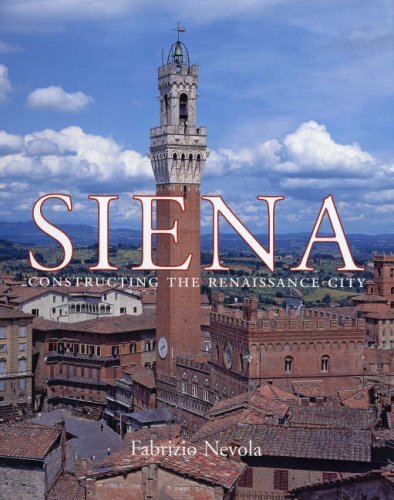
I spent two weeks in Siena in 2019, one of the most memorable experiences in my travels around Italy; living in a medieval city, walking over cobblestones through narrow winding streets, seeing Renaissance masterpieces in museums and churches, and strolling across Piazza del Campo.
Summer in Siena is prime tourist season, but it’s possible to escape them by ducking down side streets with quaint shops, quiet cafes, and small parks.
Even traveling to Siena is enjoyable. You’ll likely pass through Florence or Pisa and see Tuscan hilltop towns and valleys rich in soil for growing grapes and olives. Tuscan olive oil is considered some of the finest in the world, a source of pride for Tuscans.
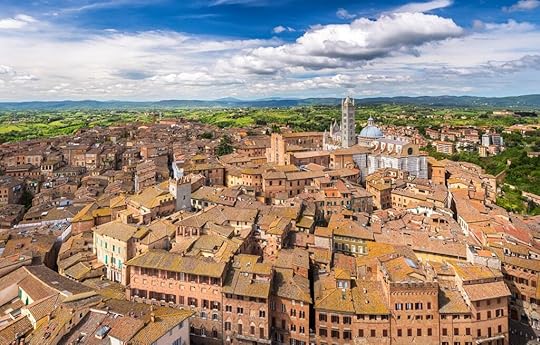
Siena is similar to other towns in central Tuscany, enclosed by high brick walls, towers, and arched gates or porta. Streets are narrow, with brick and stone pavement, which limits car traffic.
A unique feature of Siena is that it has preserved its medieval heritage, divided into seventeen neighborhoods called contrade. Each contrada has sculptures of animals which appear on their colorful flags, banners, and costumes.
My apartment in 2019 was in the panther contrada. Every morning when I walked out to attend classes, I passed a stone sculpture of a panther poised to leap on prey. A memory I’ll never forget.

Siena’s 13th Century Duomo
I was fortunate that my apartment was a three minute walk to Siena’s 13th century Duomo, a majestic example of Gothic architecture. The cathedral’s impressive facade and interior were constructed with white and dark green granite stones stacked on top of each other. White and green represent Siena’s colors.
Tours of the Duomo begin by ascending a narrow, winding staircase to the bell tower and looking over the Piazza del Duomo below. 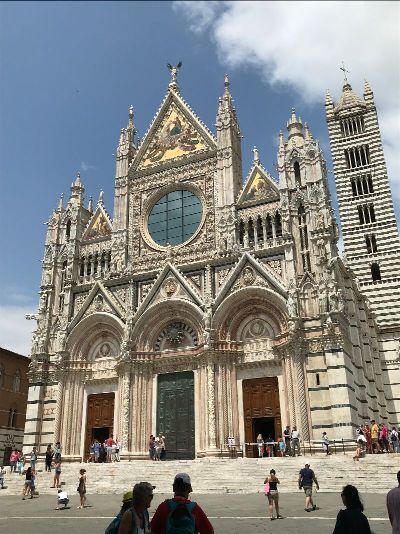
A guide leads you under the Duomo’s steep, sloping roof, walking carefully over wooden planks. You have to watch where you step and duck so you don’t bump your head on wooden beams.
At certain stations, you can peer down into the sanctuary or step out onto narrow balconies on the Duomo’s roof with stunning views of the city and surrounding Tuscan hills.
Duomo’s art includes works by Michaelangelo and Donatello and frescoes by Lorenzetti. Stonework on the sanctuary’s floors includes Biblical scenes, signs of the zodiac, and banners of legendary Siena’s medieval families.
Piazza del Campo
The center of Siena includes Piazza del Campo, Palazzo Pubblico and Torre del Mangia, the second highest tower in Tuscany. Palazzo Pubblico, constructed in the 1300’s, includes municipal offices, a courtyard, entrance to Torre del Mangia, and a museum with Renaissance paintings and frescoes.
June and July are exciting times to be in Siena as it prepares for the Palio. On June evenings, residents of Siena’s contrade parade through their neighborhoods carrying colorful flags and banners, a tradition that dates to medieval times.
Contrade flags also line the walls of the Piazza del Campo and throughout each neighborhood.
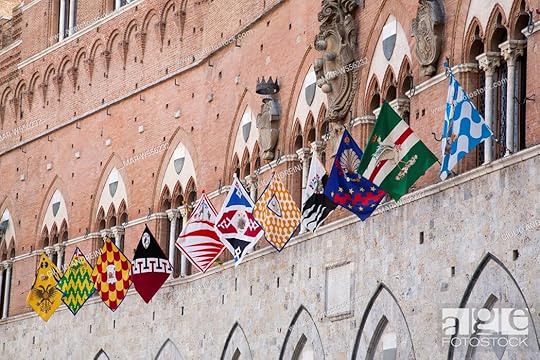

Contrade parades
On June weekends, patriotic citizens from Siena’s contrade show their colors — literally. Families dress in colorful medieval costumes and march through their contrada to the sound of thunderous drums, tossing flags (bandiera) in the air, twirling, turning, catching them, rehearsing for Palio parades before the bareback races.
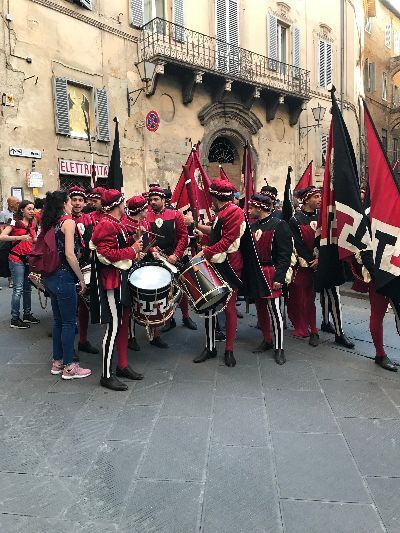

La Scuola da Vinci
Siena is the fourth city where I studied l’italiano intensivo with the La Scuola da Vinci program. On the first day, students are tested and assigned to three levels: beginning, intermediate, and advanced classes. Students come from all over the world. In Siena, my intermediate class included students from Korea, Taiwan, Russia, the UK, Switzerland, and Austria. Only one other American.
Daily assignments include conversations in Italian about daily life — shopping for clothes and food, transportation, technology, pets, families, cooking, and entertainment. Teachers lead exercises to build vocabulary, understand unique phrases, and use complicated verb tenses.
S cuola cucina
One evening, I joined a few classmates for a cooking class, ‘scuola cucina,’ at Trattoria Fonte Giusta, a local restaurant.
After meeting chefs, we mixed flour, eggs, potatoes, and salt to form moist balls of dough which we rolled and rolled then sliced to make gnocchi, ravioli, and a local pasta pici (pronounced ‘peachy’). Pici are long strings of pasta served with traditional Tuscan specialties: cacio e pepe (cheese and pepper), pesto, and ragu meat sauces.
After preparing pasta and gnocchi, we worked alongside chefs in the kitchen cooking ragu, (meat, tomatoes, onions, herbs, olive oil, salt, pepper), chicken and potatoes with herbs, and roasted vegetables. For dessert, a few students made a fruit cake and gelato.
After three hours in the kitchen, we were escorted into Trattoria Fonte Giusta’s dining room to be served our creations. Our class marveled how delicious — and fresh — our meal was that we had prepared.
Needless to say, none of us who went to scuola cucina finished our compiti (homework) that night. But we shared stories the next morning with classmates and teachers about what we learned at scuola cucina.
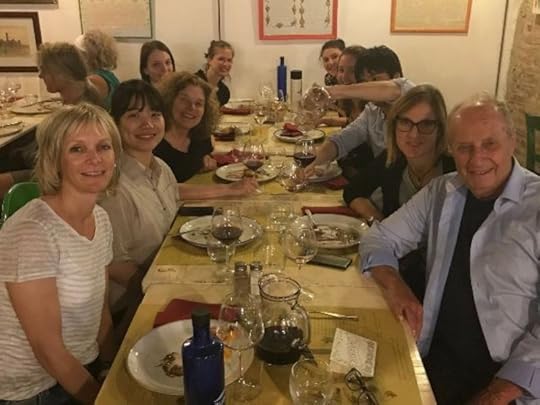
If you’re interested in reading more about Siena, I recommend two books, The Italian Party by Christina Lynch, and A Month in Siena by Hisham Matar.
The Italian Party is an enchanting read, part romance, part mystery, with tantalizing drama on each page. It’s a love letter to Siena.
A Month in Siena is how a person can develop a deeper understanding of life by immersing themselves in art, especially art in Siena. Hisham Matar did; so can you.
We’ve been in Italia for more than a month, several days in Stresa on Lago Maggiore and also in Milano to see Italian and American friends. I’ve been in Milano every year since 2011 (except 2020, of course), returning every summer for researching my Milan Thriller Series.
The paperback of Book 4, The Lonely Assassin, was published recently. I’m working on book 5 of the series, following the Italian anti-terrorism police, Digos, as they investigate incidents to prevent a terrorist attack in Italia.
I’ll announce the title and plot summary of book 5 in a few weeks.
* * * * * ***In addition to this travel blog, I write international thrillers, mysteries, short mysteries, true crime, and romantic suspense novels.
I’m currently writing the Milan Thriller Series featuring Italy’s anti-terrorism police, DIGOS (Divisione Investigazioni Generali e Operazioni), as they pursue domestic and international terrorists.
I travel to Italy every summer for research, to see Italian and American friends, to work with my researchers, and to meet DIGOS officers at Milan’s Questura (police headquarters) who advise me with DIGOS investigative procedures.
If you’d like to receive a free ebook of the first book in the series, Thirteen Days in Milan, please sign up on the left side bar. I just need your name and email address.
You can find the Milan Thriller Series and all my ebooks at digital book sites and on my publisher’s website, RedBrickPress.net. Book 4 in the Series, The Lonely Assassin, was published as a paperback in 2022.
Paperbacks of Thirteen Days in Milan, No One Sleeps, Vesuvius Nights and The Lonely Assassin are available at RedBrickPress.net, Amazon, and independent bookstores. If they’re not in stock, stores can order from my Ingram distributor. You should have your book in 3 or 4 days.
If you’d like to learn more about Italy, travel, and writing, sign up for my email newsletter at my publisher’s website or my personal web site jackerickson.com.
I like hearing from readers! Please email me and tell me what you like to read. And please share this site with friends who like to read about travel.
A presto –
Jack
Find my books in Apple’s iBookstore
At Amazon including # 1 Kindle best seller “Perfect Crime”
View my Smashwords profile:
Twitter: @JackLErickson
Summer in Italia 2023
The first running this summer of the Palio in Siena was Sunday July 2. You can read about it here.
Twice every summer, Siena hosts two runnings of the bareback horse race July 2 & August 16 around the Piazza del Campo. The Palio is more than a one day event, the city is vibrant with several activities among the various contrade or sections of the city.
We were in Lucca in northern Tuscany on July 2 and watched the local news to see that incredible horse race in the Piazza del Campo.

I spent two weeks in Siena in 2019, one of the most memorable experiences in my travels around Italy; living in a medieval city, walking over cobblestones through narrow winding streets, seeing Renaissance masterpieces in museums and churches, and strolling across Piazza del Campo.
Summer in Siena is prime tourist season, but it’s possible to escape them by ducking down side streets with quaint shops, quiet cafes, and small parks.
Even traveling to Siena is enjoyable. You’ll likely pass through Florence or Pisa and see Tuscan hilltop towns and valleys rich in soil for growing grapes and olives. Tuscan olive oil is considered some of the finest in the world, a source of pride for Tuscans.

Siena is similar to other towns in central Tuscany, enclosed by high brick walls, towers, and arched gates or porta. Streets are narrow, with brick and stone pavement, which limits car traffic.
A unique feature of Siena is that it has preserved its medieval heritage, divided into seventeen neighborhoods called contrade. Each contrada has sculptures of animals which appear on their colorful flags, banners, and costumes.
My apartment in 2019 was in the panther contrada. Every morning when I walked out to attend classes, I passed a stone sculpture of a panther poised to leap on prey. A memory I’ll never forget.

Siena’s 13th Century Duomo
I was fortunate that my apartment was a three minute walk to Siena’s 13th century Duomo, a majestic example of Gothic architecture. The cathedral’s impressive facade and interior were constructed with white and dark green granite stones stacked on top of each other. White and green represent Siena’s colors.
Tours of the Duomo begin by ascending a narrow, winding staircase to the bell tower and looking over the Piazza del Duomo below. 
A guide leads you under the Duomo’s steep, sloping roof, walking carefully over wooden planks. You have to watch where you step and duck so you don’t bump your head on wooden beams.
At certain stations, you can peer down into the sanctuary or step out onto narrow balconies on the Duomo’s roof with stunning views of the city and surrounding Tuscan hills.
Duomo’s art includes works by Michaelangelo and Donatello and frescoes by Lorenzetti. Stonework on the sanctuary’s floors includes Biblical scenes, signs of the zodiac, and banners of legendary Siena’s medieval families.
Piazza del Campo
The center of Siena includes Piazza del Campo, Palazzo Pubblico and Torre del Mangia, the second highest tower in Tuscany. Palazzo Pubblico, constructed in the 1300’s, includes municipal offices, a courtyard, entrance to Torre del Mangia, and a museum with Renaissance paintings and frescoes.
June and July are exciting times to be in Siena as it prepares for the Palio. On June evenings, residents of Siena’s contrade parade through their neighborhoods carrying colorful flags and banners, a tradition that dates to medieval times.
Contrade flags also line the walls of the Piazza del Campo and throughout each neighborhood.


Contrade parades
On June weekends, patriotic citizens from Siena’s contrade show their colors — literally. Families dress in colorful medieval costumes and march through their contrada to the sound of thunderous drums, tossing flags (bandiera) in the air, twirling, turning, catching them, rehearsing for Palio parades before the bareback races.


La Scuola da Vinci
Siena is the fourth city where I studied l’italiano intensivo with the La Scuola da Vinci program. On the first day, students are tested and assigned to three levels: beginning, intermediate, and advanced classes. Students come from all over the world. In Siena, my intermediate class included students from Korea, Taiwan, Russia, the UK, Switzerland, and Austria. Only one other American.
Daily assignments include conversations in Italian about daily life — shopping for clothes and food, transportation, technology, pets, families, cooking, and entertainment. Teachers lead exercises to build vocabulary, understand unique phrases, and use complicated verb tenses.
S cuola cucina
One evening, I joined a few classmates for a cooking class, ‘scuola cucina,’ at Trattoria Fonte Giusta, a local restaurant.
After meeting chefs, we mixed flour, eggs, potatoes, and salt to form moist balls of dough which we rolled and rolled then sliced to make gnocchi, ravioli, and a local pasta pici (pronounced ‘peachy’). Pici are long strings of pasta served with traditional Tuscan specialties: cacio e pepe (cheese and pepper), pesto, and ragu meat sauces.
After preparing pasta and gnocchi, we worked alongside chefs in the kitchen cooking ragu, (meat, tomatoes, onions, herbs, olive oil, salt, pepper), chicken and potatoes with herbs, and roasted vegetables. For dessert, a few students made a fruit cake and gelato.
After three hours in the kitchen, we were escorted into Trattoria Fonte Giusta’s dining room to be served our creations. Our class marveled how delicious — and fresh — our meal was that we had prepared.
Needless to say, none of us who went to scuola cucina finished our compiti (homework) that night. But we shared stories the next morning with classmates and teachers about what we learned at scuola cucina.

If you’re interested in reading more about Siena, I recommend two books, The Italian Party by Christina Lynch, and A Month in Siena by Hisham Matar.
The Italian Party is an enchanting read, part romance, part mystery, with tantalizing drama on each page. It’s a love letter to Siena.
A Month in Siena is how a person can develop a deeper understanding of life by immersing themselves in art, especially art in Siena. Hisham Matar did; so can you.
We’ve been in Italia for more than a month, several days in Stresa on Lago Maggiore and also in Milano to see Italian and American friends. I’ve been in Milano every year since 2011 (except 2020, of course), returning every summer for researching my Milan Thriller Series.
The paperback of Book 4, The Lonely Assassin, was published recently. I’m working on book 5 of the series, following the Italian anti-terrorism police, Digos, as they investigate incidents to prevent a terrorist attack in Italia.
I’ll announce the title and plot summary of book 5 in a few weeks.
* * * * * ***In addition to this travel blog, I write international thrillers, mysteries, short mysteries, true crime, and romantic suspense novels.
I’m currently writing the Milan Thriller Series featuring Italy’s anti-terrorism police, DIGOS (Divisione Investigazioni Generali e Operazioni), as they pursue domestic and international terrorists.
I travel to Italy every summer for research, to see Italian and American friends, to work with my researchers, and to meet DIGOS officers at Milan’s Questura (police headquarters) who advise me with DIGOS investigative procedures.
If you’d like to receive a free ebook of the first book in the series, Thirteen Days in Milan, please sign up on the left side bar. I just need your name and email address.
You can find the Milan Thriller Series and all my ebooks at digital book sites and on my publisher’s website, RedBrickPress.net. Book 4 in the Series, The Lonely Assassin, was published as a paperback in 2022.
Paperbacks of Thirteen Days in Milan, No One Sleeps, Vesuvius Nights and The Lonely Assassin are available at RedBrickPress.net, Amazon, and independent bookstores. If they’re not in stock, stores can order from my Ingram distributor. You should have your book in 3 or 4 days.
If you’d like to learn more about Italy, travel, and writing, sign up for my email newsletter at my publisher’s website or my personal web site jackerickson.com.
I like hearing from readers! Please email me and tell me what you like to read. And please share this site with friends who like to read about travel.
A presto –
Jack
Find my books in Apple’s iBookstore
At Amazon including # 1 Kindle best seller “Perfect Crime”
View my Smashwords profile:
Twitter: @JackLErickson
June 14, 2023
A Year and A Day
Type your email…
Subscribe
Venezia – La Serenissima
Type your email…
Subscribe
December 3, 2021
Sampling truffles in Alba
October and November are truffle (tartufo) season in Piemonte in northwestern Italia. I was studying Italian in Torino in early October and joined a few classmates one weekend. We took a train from Torino to Alba, famous for its truffle (tartufo) festivals. in
 Classmates from Ciao Italia school in Torino
Classmates from Ciao Italia school in TorinoAfter strolling down the Alba’s narrow streets passing wine shops, coffee shops, and cafes, we went into the tartufo festival with exhibits of truffles, wines, and foods made with truffles added including cheeses, olive oils, salts, salsas, and pastas.
There are two kinds of tartufo, white (bianco) and black (nero). Bianco tartufo are expensive, costing several hundred Euros for samples the size of a golf ball. A slice of a bianco tartufo can cost 20 Euros.
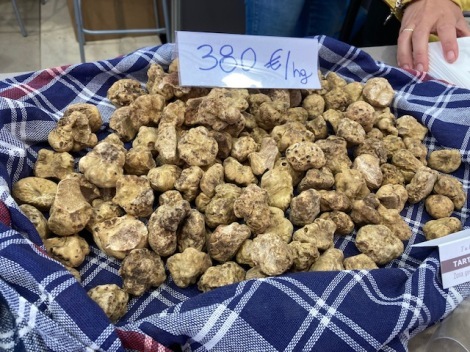 White Truffles
White TrufflesNero tartufo are more affordable, about 20 Euros for samples the same size.
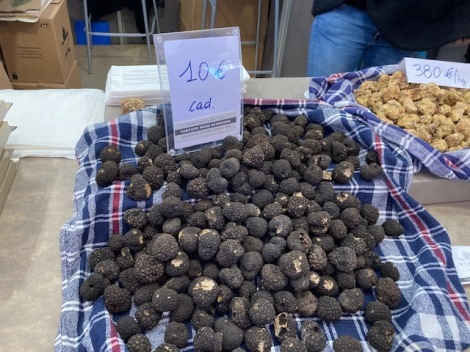 Black (nero) truffles
Black (nero) trufflesTruffle spores attach themselves to the roots of local trees in the spring and grow through the summer. In the fall, farmers take their dogs or pigs into forests and follow them. When the animals smell truffles buried under ground, they’ll dig for them. But farmers will stop the animals before they can eat them. Sometimes they can; other times, the animals get to enjoy tasty treats they uncovered.
Mushrooms and funghi also grow in profusion in Piemonte forests, some the size of a soccer ball.
 Funghi
Funghi
 Giant mushrooms
Giant mushroomsVendors of bianco and nero tartufo display them under glass cups. To sample the aroma, a hostess will raise a glass with slits in a plastic cover and press close to your nose for you to sniff the aroma. Fragrant, with tones of fruits such as pear, melon, and honey. Subtle, but memorable.


Vendors at the festival sell cheeses, sausages, pasta, olive oil, salt and salsa made with truffles.

 Pasta with truffles
Pasta with truffles
 Cheeses with truffles
Cheeses with trufflesI bought several truffle treats and brought them back to Monterey when I returned in November. I’ll remember that Interesting weekend we spent in Alba sampling tartufo.
* * * * *In addition to this travel blog, I write international thrillers, mysteries, and romantic suspense novels.
I’m currently writing the Milan Thriller Series featuring Italy’s anti-terrorism police, DIGOS (Divisione Investigazioni Generali e Operazioni), as they pursue domestic and international terrorists.
I travel to Italy every summer for research, to see Italian and American friends, to work with my researchers, and to meet DIGOS officers at Milan’s Questura (police headquarters) who advise me with DIGOS investigative procedures.
If you’d like to receive a free ebook of the first book in the series, Thirteen Days in Milan, please sign up on the left side bar. I just need your name and email address.
You can find the Milan Thriller Series and all my ebooks at digital book sites and on my publisher’s website, RedBrickPress.net. Book 4 in the Series, The Lonely Assassin, was published as an ebook in 2020. The paperback will be published in 2022.h
Paperbacks of Thirteen Days in Milan, No One Sleeps, and Vesuvius Nights are available at RedBrickPress.net, Amazon, and independent bookstores. If they’re not in stock, stores can order from the Ingram distributor. You should have your book in 3 or 4 days.
If you’d like to learn more about Italy, travel, and writing, sign up for my email newsletter at my publisher’s website or my personal web site jackerickson.com.
I like hearing from readers! Please email me and tell me what you like to read. And please share this site with friends who like to read about travel.
Find my books in Apple’s iBookstore At Barnes & Noble
At Amazon including # 1 Kindle best seller “Perfect Crime”
View my Smashwords profile:
Twitter: @JackLEricksonSkip to the selected blockOpen publish panel
November 15, 2018
Elena Ferrante’s “My Brilliant Friend”
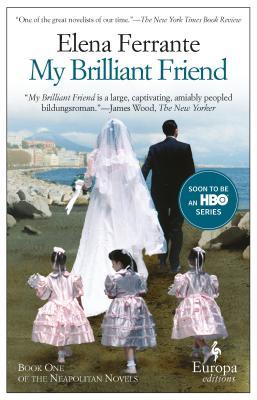
Naples-born author Elena Ferrante has swept through the literary world like a whirlwind. If you’ve read her novels, you’ll understand why she’s so popular.
Neapolitan Series
Ferrante’s first novel in her best-selling Neapolitan series, My Brilliant Friend, premieres on HBO Sunday. The series features two young girls Elena and Lila, growing up in an impoverished Naples neighborhood when the city was still recovering from the ravages of the Allies battling Nazi forces street by street in 1944.
You can preview the HBO movie on Ferrante’s website:Elena Ferrante. Her publisher, Europa Editions, has arranged #FerranteNightFeverevents at bookstores across the US leading up to the HBO premiere.
Meet Elena and Lila
In the Neapolitan series, Elena (or Lenu’ in Naples dialect, Ferrante’s autobiographical character) and Lila maintain a powerful emotional bond that lasts for decades. But the girls have different personalities: Elena is sensitive and emotionally expressive; Lila is inscrutable and tempermental. Their relationship is troubled by their differences.
Who is Elena Ferrante?
Ferrante is passionate about her privacy. She uses this pen name to remain behind the curtain, not granting interviews, attending book fairs, or revealing her name.
When an Italian journalist reported that he had discovered her identify, social media exploded with indignation and rage. “If she wants to protect her identity, let her!” was the message from fans. They respect her for wanting to maintain her privacy and not become a public figure.
BBC wrote a defense of her privacy, saying that Ferrante fever has spread around the world and gathered millions of readers of her four book series that spans 50 years of two girls maturing into women, wives, and mothers.
The Public Ferrante
But Ferrante is not shy, she maintains a public presence — behind her pen name. She writes a weekly column in The Guardian, mostly personal essays about life, hope, writing — and privacy.
I read My Brilliant Friendwhen I was researchingVesuvius Nights which takes place in contemporary Napoli. Walking the backstreets of Naples this summer, I could almost see Lenu’ and Lila walking home from school, playing in a park, or sitting on a bench, talking about their lives and dreams. Ferrante’s characters last long after you’ve read the last page.
Book 4 in the Neapolitan Series
Ferrante’s final book in the four-book series, The Story of a Lost Child, finds Elena searching for Lila late in life. Her lifelong friend has disappeared and not left notes, letters, or hints about where she is.
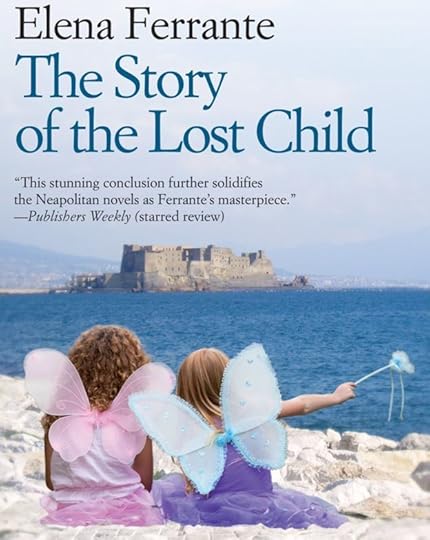
Have you read Ferrante?
If you haven’t already, I encourage you to read a Ferrante novel and discover her unique story telling talents.
Her writing is superb, she draws you in with prose that is almost haunting. You have to continue reading to follow what is going through Elena’s imaginative and searching mind.
Please share your thoughts if you’ve read a Ferrante novel or after you watch the HBO series. You can reach me on my Publisher’sor personal web sites.
* * * *
In addition to this travel blog, I write international thrillers, mysteries, and suspense novels.
I’m currently writing a thriller series based in Milan featuring the anti-terrorism police, DIGOS, as they pursue domestic and international terrorists. I travel to Milan every summer for research, to see my Italian and American friends, and to work with my researcher and translator.
If you’d like to receive a free ebook of my first Milan thriller, Thirteen Days in Milan, please sign up on the left side bar. I just need your name and email address.
The second book in the series, No One Sleeps, follows DIGOS agents as they track down a sleeper cell of Muslim terrorists in Milan who have received toxic chemicals from Pakistan to make deadly sarin gas.
You can find my ebooks all digital book sites. Paperbacks of Thirteen Days in Milan and No One Sleeps are available at Amazon and independent bookstores around the world. If they’re not in stock, stores can order from Ingram distributors. You should have your book in 3 or 4 days.
Book 3 in the series, Vesuvius Nights, will be published as an ebook in January and a paperback in May 2019. If you’d like to learn more about Italy, travel, and writing, sign up for my email newsletter at my publisher’s web site, RedBrickPress.net or my personal web site jackerickson.com.
I like hearing from readers! Please email me and tell me what you like to read. And please share this site with friends who like to read about travel.
http://www.jackerickson.com
Find my books in Apple’s iBookstore
At Barnes & Noble
At Amazon including # 1 Kindle best seller “Perfect Crime”
View my Smashwords profile:
Twitter: @JackLErickson
November 10, 2018
Armistice Day 100th Anniversary
[image error]
“The Lamps are going out all over Europe . . . we shall not see them again in our lifetime,” wrote Sir Edward Grey, British foreign secretary on August 3, 1914.
Grey’s statement proved more than prophetic, it was recognition that the world would never be the same once the armies of Triple Entente of Britain, France, and Russia confronted the armies of Germany, Austria-Hungary, and Italy on the battlefields. What had happened on battlefields in previous wars would also be changed forever because of advances in technology, unleashing the deadly might of aircraft, armoured tanks, machine guns, chemistry, and submarines.
[image error]
British fund raising poster
What Grey and many others lamented in 1914 was that in the decades leading up to the Great War, Europe was experiencing the excitement of Belle Epoque, the Beautiful Era, of new music, literature, art, and culture that had brought peace and prosperity to the world. The hopes and promises of Belle Epoque were extinguished when the first artillery shells exploded over France and Belgium in August 1914.
For four years, the Great War roiled across western and eastern Europe, the Middle East, the Balkans, and Africa. The numbers were staggering. Casualties (killed, missing, prisoners of war) included 22 million: Russia 9 million, Britain 3 million, France 6 million, America 300 K, and 1 million from allies in Japan, Romania, Serbia, Belgium, Greece, Portugal, and Montenegro.
[image error]
The Paths of Glory
Triple Entente losses were 15 million: Germany 7 million, Austria-Hungary 7 million, 900 K Turkey, and 300 K Bulgaria.
By the time of the Armistice was signed on November 11, 1918, the Russian Romanov monarchy had ended with the assassination of Tsar Nicholas and his family. So had the empires of Austria – Hungary and the Ottomans. In their places Bolshevism rose in Russia, nazism in Germany, and fascism in Italy. The world had forever changed.
The ravages of the Great War touched virtually everyone from aristocratic and privileged families, to the urban middle class and rural impoverished.
[image error]
The Gassed – John Singer Sargent
[image error]
The Great War inspired artists, musicians, poets, writers to document the bloodshed and horrors of battlefields: John Singer Sargent’s painting “The Gassed,” Erich Maria Remarque’s novel, “All Quiet on the Western Front,” Rupert Brooke’s poem, “The Soldier”, and Alexander Solzhenitsyn’s history “August 1914.”
[image error]
Canteen at British ammunition factory
A century after the Armistice, authors are still writing books that draw upon the Great War: William Boyd’s “Waiting for Sunrise,” Neal Bascomb’s “The Escape Artists,” and Daniel Mason’s “The Winter Soldier.”
[image error]
German postcard celebrating the sinking of the Lusitania
It has been more than 100 years since the onset of the Great War. But for those who heard grandparents, parents, uncles, aunts, cousins, brothers and sisters talk about those times, a lasting memory may be a simple poem they learned in school.
A poem about how quickly poppies grew around graves penned by Dr. John McCrea, a Canadian physician who officiated at the burial of a friend who had fallen in 1915 during the second battle of Ypres, Belgium.
In Flanders fields the poppies grow
Between the crosses, row on row,
That mark our place; and in the sky
The larks, still bravely singing, fly
Scarce heard amid the guns below.
We are the Dead. Short days ago
We lived, felt dawn, saw sunset glow,
Loved and were loved, and now we lie
In Flanders fields.
Take up our quarrel with the foe:
To you from failing hands we throw
The torch; be yours to hold it high.
If ye break faith with us who die
We shall not sleep, though poppies grow
In Flanders fields.
To commemorate the 100th anniversary of Armistice Day on November 11 at 11 AM on the lawn at Colton Hall, Veterans for Peace Chapter 26 Monterey, will read the names of the Fallen from Monterey from the Great War, World War II, Korea, Vietnam, Iraq, and Afghanistan. Following the reading, there will be a presentation “The Art of the Great War” at the Monterey Museum of Art.
*. *. *. *. *
In addition to this travel blog, I write international thrillers, mysteries, and suspense novels.
I’m currently writing a thriller series based in Milan featuring the anti-terrorism police, DIGOS, as they pursue domestic and international terrorists. I travel to Milan every summer for research, to see my Italian and American friends, and to work with my researcher and translator.
If you’d like to receive a free ebook of my first Milan thriller, Thirteen Days in Milan, please sign up on the left side bar. I just need your name and email address.
The second book in the series, No One Sleeps, follows DIGOS agents as they track down a sleeper cell of Muslim terrorists in Milan who have received toxic chemicals from Pakistan to make deadly sarin gas.
You can find my ebooks all digital book sites. Paperbacks of Thirteen Days in Milan and No One Sleeps are available at Amazon and independent bookstores around the world. If they’re not in stock, stores can order from Ingram distributors. You should have your book in 3 or 4 days.
Book 3 in the series, Vesuvius Nights, will be published as an ebook in January. If you’d like to learn more about Italy, travel, and writing, sign up for my email newsletter at my publisher’s web site, RedBrickPress.net or my personal web site jackerickson.com.
I like hearing from readers! Please email me and tell me what you like to read. And please share this site with friends who like to read about travel.
http://www.jackerickson.com
Find my books in Apple’s iBookstore
At Barnes & Noble
At Amazon including # 1 Kindle best seller “Perfect Crime”
View my Smashwords profile:
Twitter: @JackLErickson
September 25, 2018
Cremona – Violin Museum
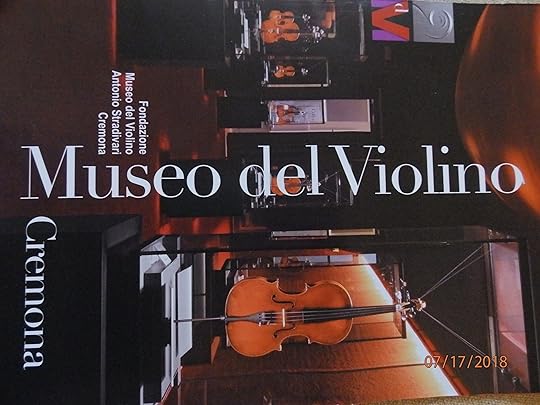
When I visit Italy, I balance my time with research, travel, studying Italian, and learning about Italy’s many contribution to art, culture, science, and history.
One of the highlights this summer was returning to Cremona to tour the Violin Museum recognized around the world as one of the most valuable collections of violins created by the early masters of the craft, Antonio Stradivarius, and the Amati and Guarneri families.
I had been to the Violin Museum in 2016, but this summer my wife was with me. We bought tickets to the museum just before noon, and noticed a concert beginning in a few minutes with a violinist who would perform with a violin made by Antonio Stradivarius in 1669.
We bought tickets and within minutes were seated in an intimate but elegant theater. An armed police officer was standing by a table near the grand piano guarding the 350-year-old Stradivarius violin.
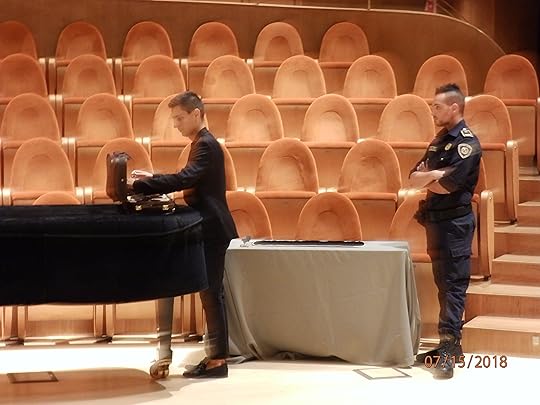
When the performer, Aurelia Macovei, entered the theatre, she was warmly greeted with applause. Ms. Macovei picked up the violin, tuned it with a few gentle strokes, then announced her first selection.
For the next 45 minutes we were treated to a performance of fifteen concerti (no photos allowed during the concert). An amazing, once in a lifetime experience.
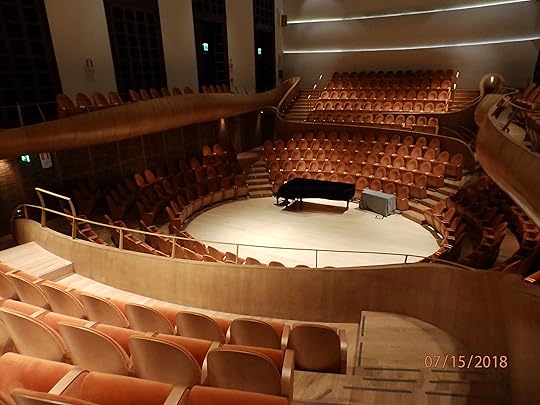
After the concert, we toured the Violin Museum which has impressive displays and exhibits of the craft of violin making. Consider the many intricacies of creating a violin — selecting the right woods, carving with precision tools to make the bridge, neck, scroll, finger board, belly chin rest and ribs. There are more than thirty separate wooden parts of a violin. And then the strings.

The most famous violin maker (luthier) in Cremona was Antonio Stradivarius (1644 – 1737). But Stradivarius was not the only luthier in Cremona, two other families were the Amati and Guarneri who also apprenticed young luthiers.
Stradivari, Amati, and Guarneri violins are worth millions, regarded as the finest in the world. Several Stradivari, Amati, and Guarneri violins are displayed in a special hall, each with date they were made and a distinctive name.

Cremona honours Stradivari with statues in front of the museum and Piazza Stradivari, the city’s main square.
Cremona is a two hour train or drive from Milano. If you’re planning a trip to Italy, consider an excursion to Cremona to tour the Violin Museum. You’ll be impressed and understand why it’s a very special destination.
A presto!
* * * * *
In addition to writing this travel blog, I write international thrillers, mysteries, and suspense novels.
I’m currently writing a thriller series based in Milan featuring the anti-terrorism police, DIGOS, as they track down domestic and international terrorists.
If you’d like to receive a free ebook of my first thriller, Thirteen Days in Milan, please sign up on the left side bar. I just need your name and email address.
The second book in the series, No One Sleeps, follows DIGOS agents as they track down a sleeper cell of Muslim terrorists in Milan who have received toxic chemicals from Pakistan to make deadly sarin gas.
You can find my books at Amazon and all digital book sites. Paperbacks of Thirteen Days in Milan and No One Sleeps are also available at Amazon and at independent bookstores around the world.
Book 3 in the series, Vesuvius Nights, will be published as an ebook in November and a paperback in 2018. If you’d like to learn more about Italy, travel, and writing, sign up for my email newsletter at my publisher’s web site, RedBrickPress.net or my personal web site jackerickson.com.
I like hearing from readers! Please email me and tell me what you like to read.
http://www.jackerickson.com
Find my books in Apple’s iBookstore
At Barnes & Noble
At Amazon including # 1 Kindle best seller “Perfect Crime”
View my Smashwords profile:
Twitter: @JackLErickson
November 20, 2016
Prologue: “No One Sleeps” The Egyptian Imam
PROLOGUE
The Egyptian Imam
Milan
February 17, 2003
Shortly before noon on a bitterly cold February day, a plainclothes maresciallo (marshal) of the Carabinieri military police shouted “Polizia!” and stopped a Muslim man on Via Guerzoni in Milan. *1
The Muslim was an imam dressed in a traditional galabia tunic and taqiyah skullcap on his way to noon prayers at the Islamic Cultural Institute on Viale Jenner. The policeman flashed his identification and asked for the man’s papers. Hasaan Mustafa Osama Nasr, also known as Abu Omar, handed over his passport, residency permit, and identification papers. He said in broken English that he didn’t speak Italian.
The policeman took his time examining Omar’s papers. Suddenly, a white cargo van that had been parked across the street pulled up, and the panel door swung open. Two husky men pulled Omar into the van and pushed him to the floor. The door slammed shut, and the van sped up Via Guerzoni into Milan’s heavy traffic.
Omar was kicked in the head, chest, and stomach. A rag was stuffed in his mouth and a mask pulled over his eyes. Within minutes, the van reached the Milan suburb of Cormano and entered the eastbound A4 autostrada, where it was joined by a car and another van as escorts. The vehicles sped north past Bergamo, Brescia, Verona, Vicenza, Padua, and Venice. The caravan left the A4, turned north on the A28, and four hours later reached a security gate at the joint Italian–U.S. Air Force Aviano Air Base, two hundred miles from Milan. *2
Omar, a fifty-eight-year old Egyptian, was a radical imam at Milan’s Islamic Cultural Institute (ICI), considered by the American CIA and Italian intelligence as a center for recruiting European Muslims to go to al Qaeda training camps in Afghanistan. Since the 1990s, the ICI, a former garage converted into a mosque, had become a spiritual refuge for thousands of Muslims living in Milan. During Friday services, worshipers spilled onto the streets, kneeling on prayer rugs on sidewalks and around the block, snarling traffic and forcing retailers to close during prayers.
Italian intelligence knew the ICI was the European headquarters of Gamaa Islamiya, a terrorist Egyptian group responsible for killing hundreds of Egyptians and Westerners in attempts to overthrow the Egyptian government. Tunisian, Libyan, Moroccan, and Algerian radicals also found a spiritual home at the ICI. *3
Omar and his captors flew on a military plane to Ramstein Air Base in Germany and transferred to a private Lear jet contracted by the CIA. The plane flew to Cairo, where Omar was arrested and taken to a prison, where he was stripped, prodded, whipped, and isolated in a small concrete box. He was repeatedly tortured. He was beaten with clubs, shocked with electrical prods, his hands and feet shackled, and forced to lie on a mat on a hard floor, freezing in cold weather, constantly attacked by mites, fleas, and mosquitoes.
After seven months, Omar was transferred to the notorious Tora prison complex known as Al-Aqrab, “the Scorpion,” where he was interrogated twice daily. Both sessions lasted for hours. He was stripped and pushed onto to a wet mattress, with guards sitting on wooden chairs over him as electricity surged through the mattress.
After attempts to locate Omar, the Italian police investigated reports that he had been kidnapped. The antiterrorism police, Divisione Investigazioni Generali e Operazioni Speciali, or DIGOS, had raided the ICI in 1995 under code name “Sphinx” and had found tools for forging passports and legal documents, radical Islamic publications, and forged papers. On September 4, 2001, DIGOS discovered downloaded photos of the Twin Towers taken at night on a computer at the Via Quaranta mosque in southern Milan, suggesting there was prior knowledge of the 9/11 attack in the Milan Muslim community. *4
DIGOS studied logs of cell phone SIM cards from cell towers on the Best Western hotel near Via Guerzoni and tracked 10,317 calls made between 11 a.m. and 1 p.m. They narrowed the calls to eleven made to each other in a flurry around 11 a.m. The calls trailed off until seven more SIM cards were tracked near Cormano, calling each other from escort vehicles approaching the A4 autostrada. DIGOS identified another thirty-four SIM cards, a network of connected callers, leading up to and after the kidnapping. DIGOS traced the owners of the SIM cards with further data collected from hotel registries, car rentals, and frequent flyer numbers. They identified twenty-five Americans, many with post office addresses near the CIA headquarters in McLean, Virginia. *5
One of the cards belonged to the CIA station chief at the American consulate in Milan. Another SIM card was linked to an American diplomat in Rome known to be a CIA agent. A third SIM card was traced to the American security chief at Aviano Air Base. One caller had photos of Abu Omar on his laptop computer, taken before his kidnapping.
Prosecutor Armando Spataro was assigned to the case to see if charges could be brought against the suspected kidnappers. Spataro was a highly respected jurist who had prosecuted cases in the infamous 1980s Anni di Piombo (Years of Lead) involving left- and right-wing terrorists, including the infamous Brigate Rosse (Red Brigades), who had murdered hundreds of people in hopes of igniting a violent revolution in Italy.
In April 2005, Spataro issued indictments and arrest warrants for nineteen Americans traced from SIM cards. The warrants were valid throughout the European Union, making Italy the first country to take such legal actions against American citizens. Prime Minister Silvio Berlusconi summoned the American ambassador to Chigi Palace in Rome for what was described as a stern lecture on Italian sovereignty. *6
In July 2006, two high-ranking officials of the Italian Military Intelligence and Security Service (SISMI) were also charged with assisting the CIA in the operation.
The kidnapping of foreigners is a violation of American law under the United Nations Convention Against Torture signed by President Clinton in 1994. But after 9/11, President George W. Bush authorized American agencies to kidnap and transport suspected terrorists to foreign prisons to be tortured under the term “extraordinary rendition.” Abu Omar was one of hundreds of suspected foreign terrorists American agencies “rendered” after 9/11. *7
In June 2007, the Tribunal of Milan set a trial for the twenty-three Americans in absentia. Italian law allows trials for defendants who do not show up in court. In November 2009, Judge Oscar Magi convicted twenty-three Americans, all but one of whom were CIA agents. Many were given prison sentences, including the Milan CIA station chief. Two high officials from the Italian Military Intelligence and Security Service (SISMI) were also convicted. In December 2010, the sentences for the convicted Americans were increased to seven to nine years on appeal, and these Americans were ordered to pay damages to Omar. *8
Italy’s Justice Ministry issued a formal request for extradition of the convicted agents. The United States refused the request. Any of the convicted who traveled to the EU faced extradition to Italy.
In April 2016, the Portugal Supreme Court authorized the extradition of one of the convicted CIA agents, a dual citizen of the U.S. and Portugal, to face prison in Italy after she traveled to Portugal in 2015.
Abu Omar spent four years in Egyptian prisons before he was released. In December 2013, he was convicted in absentia by an Italian court of terrorist crimes. He remains living in Egypt.
Steve Hendricks, A Kidnapping in Milan: The CIA on Trial (New York: W.W. Norton, 2010), p. 32
Ibid., pp. 122–123
Lorenzo Vidino, Al Qaeda in Europe: The New Battleground of International Jihad (Amherst, New York: Prometheus Books, 2006), pp. 216–219
Vidino, p. 226
Hendricks, pp.167–169
Hendricks, p. 220
Hendricks, p. 147
Hendricks, p. 277
# # # #
The ebook “No One Sleeps” will be published December 7 on all digital book sites at a discount price.
The book represents more than two years research in Milan with interviews of high level sources at the Questura (police headquarters) and other Italian institutions.
This is the second in my Milan DIGOS thriller series. The first book, “Thirteen Days in Milan,” was published in 2013. Book III in the series, “Cadorna Station,” will be published in 2017.
Please share with your friends who are interested in reading international thrillers.



